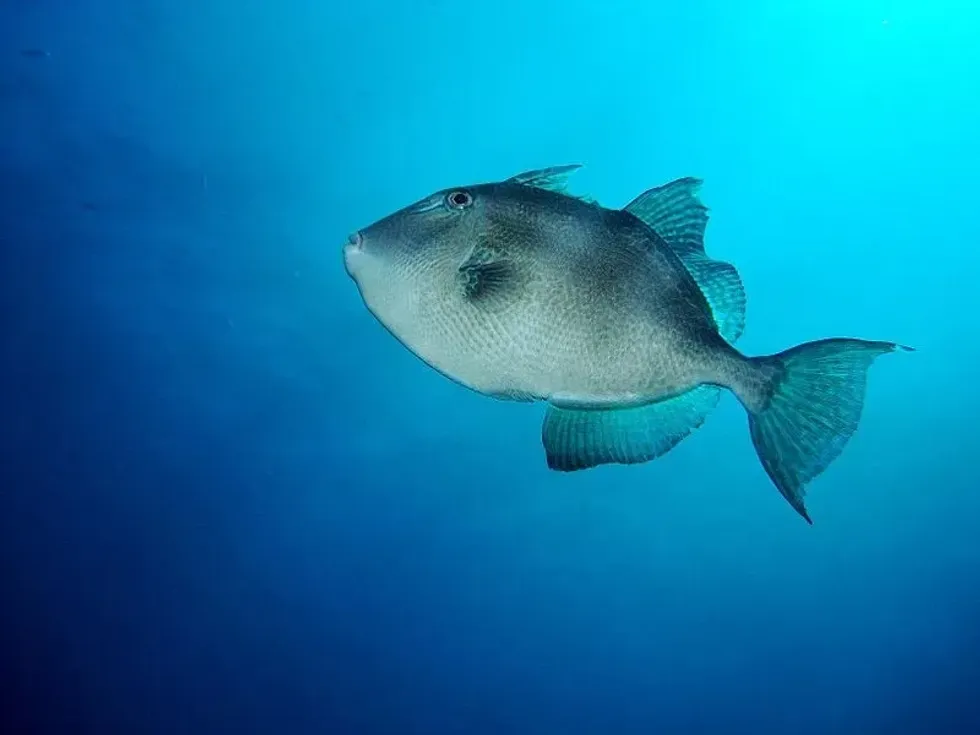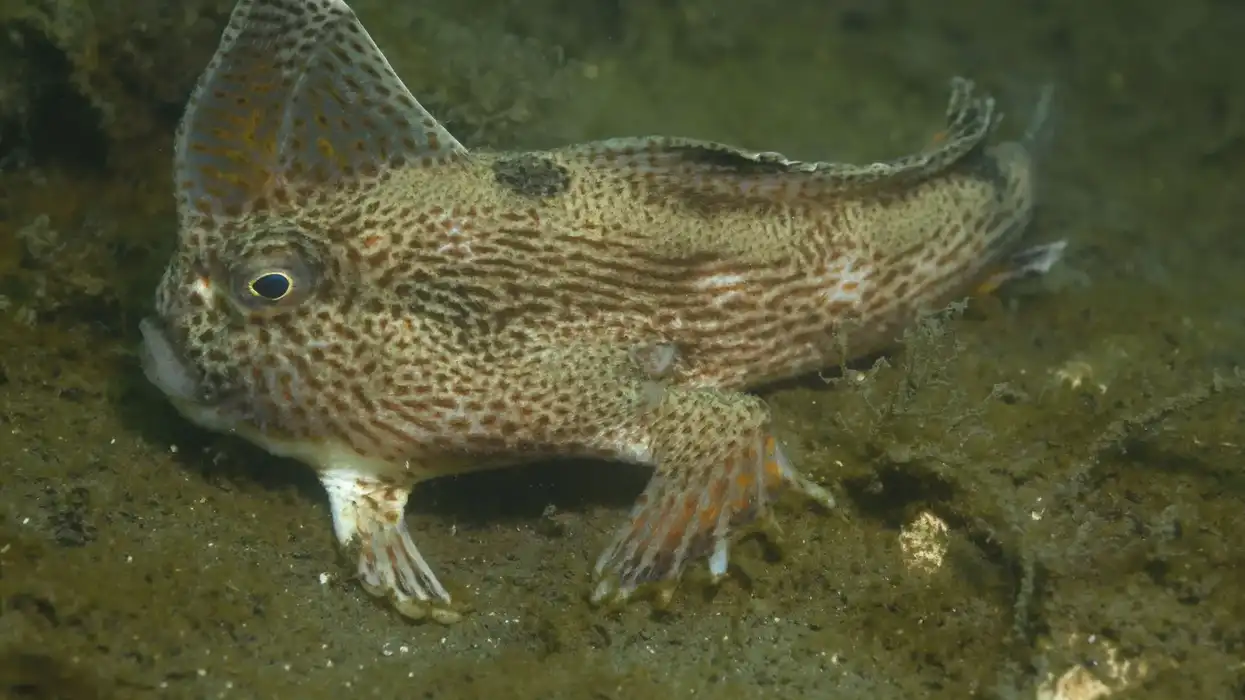The grey triggerfish has leather-like skin, so it is also known as leatherjacket, leatherneck, or taly. The color of the fish is pale grey with yellowish-brown or greenish-grey hues.
Irregular small blue spots and lines are seen all over the upper parts of the trunk. Its body has three broad dark stripes and a pale streak on the chin. The upper side of the eye is slightly bluish.
The dorsal fins show white spots and lines on the lower side. The grey triggerfish has a small, beak-like mouth.
Its eyes are usually far apart from each other and located near the top of its head. It has different types of fins that are as following: front dorsal fin, second dorsal fin, anal fin, pectoral fin, and caudal fins. The frontal dorsal fin has three spines that are stronger and longer.
The first spine has 26-29 soft rays. The anal fin lies below the second dorsal fin and has no spines but contains 23-26 soft rays.
The pectoral fins are small and rounded. The outer rays of the caudal fins are longer. Large scales are spread all over their head and front of the body.
Small smooth scales are present on the hind body. If you enjoy reading about them, then check out the ayu fish and spotted trunkfish.
Grey Triggerfish Interesting Facts
What type of animal is a grey triggerfish?
The species of grey triggerfish (Balistes capriscus) is a ray-finned fish.
What class of animal does a grey triggerfish belong to?
Grey triggerfish belong to the category of ray-finned fishes.
How many grey triggerfish are there in the world?
There are 40 species of triggerfish that are widely spread across all the seas of the world.
Where does a grey triggerfish live?
Previously it was limited to tropical waters, but now it is becoming more and more common in cold temperate zones. This change in its range could be the result of the warming of water bodies.
What is a grey triggerfish's habitat?
The grey triggerfish (Balistes capriscus) is predominantly a species of shallow waters found in the western Atlantic Ocean and Gulf of Mexico. Its natural range extends from Nova Scotia to the Caribbean Sea, Gulf of Mexico and Bermuda, and southwards to Argentina.
Triggerfish prefer hard bottoms, reefs, and ledges of the ocean. The grey triggerfish is found in abundance in nearshore and offshore sand. This triggerfish grey dwells in bays, lagoons, and seaward reefs to depths of 180 ft (55 m).
The adult triggerfish drifts along the bottom, either alone or in small groups. The juvenile grey triggerfish float at the surface with sargassum that is found in abundance in seas and oceans.
Who does grey triggerfish live with?
They prefer to live alone. But in search of food on the same sites, they are often seen in groups. If you want to keep them in the aquarium, then it depends on what type of triggers you're putting with them.
Few are very hostile in behavior, like the queen and titan. Grey triggerfish make it very hard to keep other triggerfish and even fishes of different species in the same tank. As they grow, they get nasty.
How long does a grey triggerfish live?
The grey triggerfish lives up to a maximum age of near 13 years.
How do they reproduce?
When the water temperatures reach 69.8 F (21 C) from July to September, grey triggerfish build their nests on the bottom of the sea or ocean. Female fish can lay up to 50,000-10,000 eggs at a time that depends upon the size of the female.
The fish lay eggs in a hollow nest raised out of the gravel. Mating between males and females is polygamous and random with no long-term pair connection.
An adult guards the nest against potential predators like wrasses, red snappers, and divers. The predators steal the eggs from the nests of grey triggerfish.
The eggs that survive usually hatch within 48-55 hours. After hatching, the small fish leave their nest and head to the surface of the water. At the surface, they often associate themselves with sargassum.
Sargassum is a seaweed that usually floats on the surface of clear blue water. The amount of sargassum fluctuates from year to year.
The higher the production of sargassum, the higher is the survival rate of young triggerfish. The juveniles leave the sargassum as the autumn season approaches and swim to the bottom reef at lengths of 5-7 in (12.7-17.8 cm).
What is their conservation status?
The conservation status of grey triggerfish is Vulnerable or Threatened. Grey triggerfish are among the favorite fish in both commercial and recreational fisheries.
There are two subpopulations of grey triggerfish—the South Atlantic population and the Gulf of Mexico population. Because different factors like fishing, habitat modification, and pollution of oceans add to the health of the stock, these two varieties are managed separately.
The stock of the Gulf of Mexico was overfished.
But thanks to the rules under the Magnuson-Stevens Fishery Conservation and Management Act (MSA), the figures have gone up, and the fish population is no longer exploited. There is still a lot to do.
The stock continues to be controlled through a reconstruction plan of fisheries by a group of legal measurements envisioned to increase stock numbers. Researchers are working to raise triggerfish in captivity so that the wild population might be more likely to be left alone.
Grey Triggerfish Fun Facts
What do grey triggerfish look like?
The color of the grey triggerfish is olive to brown-grey, with irregular banding, and they can camouflage with their surroundings. They have a laterally compressed body that helps them hiding in narrow crevices in a situation of attack.
The head is large, with eyes situated wide apart from each other. They have a small but strong-jawed spout. Their teeth are sharp enough to crush hard-shelled prey like sea urchins and starfish.
How cute are they?
If you are fond of keeping fish as pets, you have a wide range of fishes like codfish, fluke fish, or suckerfish. However, compared to them, grey triggerfish is much cuter.
How do they communicate?
The mode of communication is unknown.
How big is a grey triggerfish?
Triggerfish can grow to be up to a length of 60-91 cm (24-36 in) of fork length calculated from the tip of the mouth to the center of the fork of the tail.
The dwarf minnow can grow up to a length of 3-4 in (7.62-10.16 cm) long, which means the triggerfish is eight to nine times bigger than a dwarf minnow.
How fast can a grey triggerfish swim?
The grey triggerfish are capable of high, prolonged swimming speeds of up to 4.1–1 Ls (30 min Ucrit).
How much does a grey triggerfish weigh?
The grey triggerfish weigh up to 13 lb (5.9 kg).
What are the male and female names of the species?
The male and female names of the species are the same, which is Balistes capriscus.
What would you call a baby grey triggerfish?
Baby grey triggerfish are called fish larvae.
What do they eat?
Speaking of preying, this species can truly have an attacking behavior. They usually prey upon benthic invertebrates like sea cucumbers, shrimps, mollusks, crabs, sea urchins, sand dollars, and starfish.
When they intend to hunt sand dollars, triggers often undertake a vertical position, from which they shoot a stream of water.
Once the sand dollar gets exposed from the base of the sand, triggers pounce to grab their prey with their sharp teeth. Their teeth are sharply held in strong jaws that help them to drill holes in the shells of prey like mussels and sea urchins, and sand dollar.
Are they poisonous?
The flesh of grey triggerfish taste good and are mostly appreciated by all seafood lovers, but it can seldom cause ciguatera poisoning.
Would they make a good pet?
It is a fish that has a solitary behavior and does not mix up well with other species of fish.
Did you know...
The Balistidae family takes its name from the spine that the fish use to discourage predators or to 'lock' themselves into holes, crevices, and other hiding spots. This system can be unlocked by depressing a smaller, 'trigger' spine.
Catching and eating grey triggerfish
Like many other reef fishes, eating grey triggerfish can cause ciguatera poisoning. However, other species in the triggerfish family can be eaten and are quite common because of their clean white meat.
If you're wondering how to catch grey triggerfish, we can help you out. Slowly pull within casting distance and flip your bait near the fish when you spot a triggerfish near the surface.
Typically, they'll hurry out from under the cover to attack anything within about 10 ft (3 m). But don't drip the offering on top of the fish, or it may be startled by the splish-splash.
Dangers of grey triggerfish
There have been rare cases of divers sustaining a bite from grey triggerfish teeth. Pseudobalistes fuscus and Balistotoides viridescens are the most dangerous two species of triggerfish. In normal circumstances, they are shy but become aggressive when guarding their nest.
Here at Kidadl, we have carefully created lots of interesting family-friendly animal facts for everyone to discover! Learn more about some other fishes from our brown trout facts and Atlantic cod facts pages.
You can even occupy yourself at home by coloring in one of our free printable grey triggerfish coloring pages.










